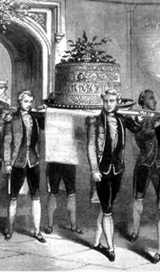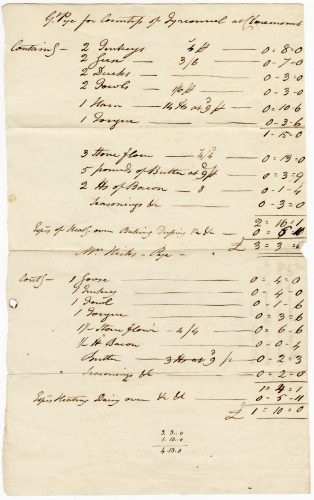Making a great pie with the Delaval Family
THE INGREDIENTS FOR MAKING A GREAT PIE FOR THE COUNTESS OF TYRCONNEL AT CLAREMONT, CIRCA 1783-1800, REFERENCE: 2DE/30/15/1
THE DELAVAL FAMILY
The Delaval family lived at Seaton Delaval in south east Northumberland but also had estates in the late 18th century at Ford (North Northumberland) and Doddington (Lincolnshire). At this time the 1st Baron Delaval, John Hussey Delaval was living at Seaton Delaval Hall. He was involved in politics and for various periods between 1754 and 1786, he was an MP for Berwick. The family were renowned for their parties and lavish entertaining at Seaton Delaval Hall.

The family relationships can be seen in the Delaval family pedigree.
💡What kind of parties do you think the Delaval family hosted?
💡How different do you think they were from parties today?
🌍 Did you know, you can visit Seaton Delaval Hall. What could you find out about their notorious parties and pranks?
COUNTESS TYRCONNEL
The Countess of Tyrconnel was Sarah Hussey Delaval (1763 –1800), the youngest daughter of John Hussey Delaval and his second wife Susanna. She married George Carpenter, 2nd Earl of Tyrconnel in 1780. Claremont House, near Esher in Surrey was their summer home.

📚Try reading the document. Can you pick out some of the ingredients in the pie?
🗣 Read the document out loud. Does this make it easier to understand?
💡Are these ingredients similar to what you would put in a pie?
💡 How do you think the pie was cooked?
✏ Compare the ingredients to the foods you have at home. Make a list of ingredients you have in common.
💡How do you think the pie was transported to Claremont House? How long must this have taken?
✏ How elaborate do you think the pie looked? Try drawing, designing or making a model of your own elaborate pie.
THE GREAT PIE
This document lists the costs for creating two pies, one for the Countess of Tyrconnel which was to be sent to her at Claremount, and the second for Mrs Elizabeth Hicks, the mistress of Baron Delaval.
The “Great Pie” must have been huge and how was it transported from Seaton Delaval to Surrey? It would have had a pastry base
and top but what size must it have been if it held – 2 turkeys; 2 geese; 2 ducks; 2 fowls; 1 ham and 1 tongue? The pastry alone was made from 42lbs (19kg) of flour and 5lbs (2kg) of butter. The total cost of making it was £3 3s 0d (equivalent to £241.80 in
2017).
The second pie, for Mrs Hicks, only contained 1 goose, 1 turkey, 1 fowl and 1 tongue. It only cost £1 10s 0d (equivalent to £115.14 in 2017) to make.
HANNAH GLASSE’S YORKSHIRE CHRISTMAS PIE
 Hannah Glasse (1708-1770), the daughter of Northumbrian landowner Isaac Allgood, was a cookbook author. In 1747 she published the cookery book ‘The Art of Cookery made Plain and Easy’. Her book has a whole chapter about making pies.
Hannah Glasse (1708-1770), the daughter of Northumbrian landowner Isaac Allgood, was a cookbook author. In 1747 she published the cookery book ‘The Art of Cookery made Plain and Easy’. Her book has a whole chapter about making pies.
One of the recipes is the Yorkshire Christmas pie, the ingredients are quite similar to the pie made for Countess Tyrconnel. Yorkshire Christmas pies can be quite elaborate. A particularly large one was made for Queen Victoria and her guests at Windsor Castle in 1857 as shown in the image below.

✏Have a go at writing a recipe for your own great pie. This could be sweet or savoury. What will you put in it?
✏How will your pie look? Sketch a design.
👩🍳Have a go at making your great pie.
📷You could take pictures of your pie and send it to us at Northumberland Archives along with the recipe.
💡 How much did it cost to make your pie? Think about hidden costs such as gas or electric to run the oven.



